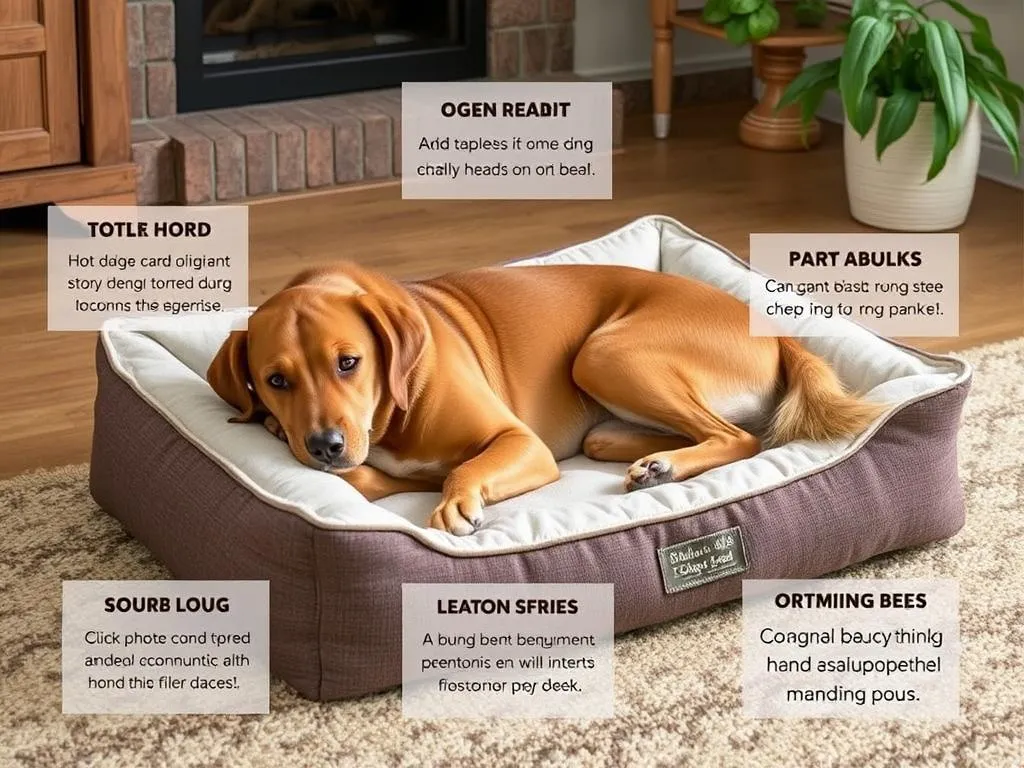
Ensuring our furry companions lead a healthy and happy life often revolves around their comfort and well-being. Just like humans, dogs need a good quality sleep environment to thrive. As pet owners become increasingly aware of the significance of proper bedding, the benefits of orthopedic dog beds have come to the forefront of discussions related to canine health.
These specialized dog beds not only provide comfort but also play a vital role in enhancing the quality of life for dogs, particularly those with specific health concerns. Let’s dive deeper into understanding orthopedic dog beds and their myriad benefits.
Understanding Orthopedic Dog Beds
Definition of Orthopedic Dog Beds
Orthopedic dog beds are designed to support a dog’s body structure, particularly the joints and bones. Unlike standard dog beds that may offer minimal cushioning, orthopedic beds use materials that conform to a dog’s body, providing targeted support where it’s needed most. This is crucial for dogs suffering from joint pain, arthritis, or other orthopedic issues.
Types of Orthopedic Dog Beds
-
Memory Foam Beds: These beds are made from viscoelastic foam that molds to the shape of the dog’s body, offering excellent support and comfort. They are particularly beneficial for older dogs or those recovering from surgery as they reduce pressure on joints.
-
Gel-Infused Beds: These incorporate cooling gel technology to maintain a comfortable temperature while providing support. They are ideal for dogs that tend to overheat or live in warmer climates.
-
Elevated Beds: Elevated or cot-style beds keep dogs off the ground, providing improved air circulation and joint support. They are especially suitable for dogs with mobility issues, as they make it easier for them to get in and out of bed.
Common Materials Used
Orthopedic dog beds often feature high-density foam, memory foam, or gel-infused foam to provide superior support. The covers are typically made from durable, washable materials, such as polyester or cotton blends, designed to withstand wear and tear while maintaining hygiene.
The Importance of Quality Sleep for Dogs
Sleep Patterns in Dogs
Dogs sleep an average of 12 to 14 hours a day, but this can vary based on factors such as age, breed, and overall health. Puppies and older dogs usually require more sleep, while younger, active breeds may have shorter sleep cycles but still need plenty of rest to recharge.
Impact of Sleep on Dog Health
Quality sleep is crucial for a dog’s mental and physical health. It allows for recovery and energy restoration. Poor sleep can lead to behavioral issues, increased stress levels, and a weakened immune system. This highlights the importance of providing a comfortable sleeping environment, which leads us back to the benefits of orthopedic dog beds.
Benefits of Orthopedic Dog Beds
Joint Health and Pain Relief
One of the most significant advantages of orthopedic dog beds is their ability to support joint health and relieve pain.
-
Arthritis Management: For dogs suffering from arthritis, these beds provide crucial support to alleviate pressure on painful joints. The cushioning allows for easier movement, reducing discomfort during sleep.
-
Hip Dysplasia: Breeds prone to hip dysplasia, such as German Shepherds or Labrador Retrievers, can benefit immensely from the supportive nature of orthopedic beds. These beds help maintain proper alignment and reduce strain on their hips.
Improved Comfort and Support
The materials used in orthopedic dog beds, such as memory foam or gel-infused foam, are designed to distribute a dog’s weight evenly. This pressure-relieving design minimizes discomfort, allowing dogs to settle into a deeper sleep without tossing and turning.
Better Sleep Quality
Orthopedic beds contribute to deeper, more restorative sleep cycles. When dogs experience better sleep quality, they are more alert and active during their waking hours, which positively impacts their overall health and happiness.
Enhanced Mobility
Proper support is essential for maintaining and improving mobility, especially in older dogs or those recovering from injuries. Orthopedic beds facilitate easier movement in and out of bed, which can prevent further injuries and foster independence in senior dogs.
Prevention of Health Issues
Investing in an orthopedic bed can help prevent future health problems related to poor support and inadequate sleep quality. By providing the right sleeping surface, pet owners can mitigate the risk of developing chronic pain or mobility issues in their dogs.
Choosing the Right Orthopedic Dog Bed
Assessing Your Dog’s Needs
Before purchasing an orthopedic dog bed, it’s essential to assess your dog’s specific needs. Consider factors such as age, breed, pre-existing health conditions, and size. For example, larger breeds or older dogs may require thicker and firmer support.
Bed Size and Dimensions
Choosing the right size is crucial for comfort and support. A bed that is too small may not provide adequate space for your dog to stretch out, while a bed that is too large may not offer the necessary support. Measure your dog while they are lying down to determine the best size.
Features to Look For
-
Washable Covers: Hygiene is vital for your dog’s health. Look for beds with removable, washable covers that are easy to clean.
-
Non-Slip Bottoms: Safety is paramount. Beds with non-slip bottoms prevent sliding and ensure your dog can get in and out safely, reducing the risk of injuries.
Price vs. Quality
While price is a consideration, it’s essential to weigh the cost against the quality offered. Investing in a high-quality orthopedic bed is worthwhile for the long-term health benefits it provides your furry friend. A well-made bed can last for years, making it a smart investment.
Maintaining Orthopedic Dog Beds
Cleaning and Care Tips
To prolong the life of an orthopedic dog bed, regular cleaning and maintenance are necessary. Here are some best practices:
-
Regularly Wash Covers: Follow the manufacturer’s instructions regarding washing. Most covers can be machine washed, which helps maintain hygiene.
-
Vacuum the Bed: Regularly vacuuming the bed helps remove hair and dirt, keeping it fresh.
-
Check for Damage: Periodically inspect the bed for signs of wear and tear. Addressing issues early can prevent further damage.
When to Replace an Orthopedic Dog Bed
Even the best orthopedic dog beds have a lifespan. Signs that it’s time for a replacement include:
-
Loss of Support: If the bed no longer holds its shape or feels flat, it may not provide the necessary support.
-
Visible Damage: Rips, tears, or stains can compromise the bed’s hygiene and comfort.
-
Unwillingness to Use: If your dog starts avoiding their bed or seems uncomfortable when lying down, it might be time for a new one.
Real-Life Success Stories
Case Studies
Many dog owners have witnessed significant improvements in their pets’ health after transitioning to orthopedic beds. For example, a Golden Retriever named Max, who suffered from severe arthritis, saw increased mobility and reduced pain after using a memory foam orthopedic bed. His owner reported that Max now enjoys longer walks and plays more often.
Expert Opinions
Veterinarians often recommend orthopedic dog beds for dogs with specific health issues. Dr. Sarah Johnson, a veterinary orthopedic specialist, states, “Investing in a quality orthopedic bed can significantly improve the quality of life for dogs with joint problems. It’s not just about comfort; it’s a proactive step towards better health.”
Conclusion
The benefits of orthopedic dog beds are numerous and significant. They provide essential support for joint health, improve comfort, enhance sleep quality, and can even prevent future health issues. By investing in an orthopedic bed tailored to your dog’s needs, you are taking an important step towards ensuring their overall health and well-being. As a loving pet owner, it’s your responsibility to provide the best care, and a quality orthopedic bed is a key component of that care.
In summary, consider the unique needs of your dog and the myriad benefits of orthopedic beds. Prioritize their comfort and health today, and watch them thrive in their golden years.









